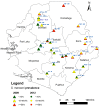Schistosoma mansoni infection after three years of mass drug administration in Sierra Leone
- PMID: 24401567
- PMCID: PMC3895768
- DOI: 10.1186/1756-3305-7-14
Schistosoma mansoni infection after three years of mass drug administration in Sierra Leone
Abstract
Background: Schistosoma mansoni was moderately-highly endemic in the northeast of Sierra Leone. The national neglected tropical disease control program started mass drug administration (MDA) with praziquantel (PZQ) in six districts in 2009 targeting primary school children only. The effort was scaled-up to seven districts in 2010 targeting school aged children (SAC) and at-risk adults. A cross-sectional sentinel site survey was conducted in 2012 after three rounds of MDA to evaluate the impact of the national program.
Methods: Twenty-six (26) sentinel sites were randomly selected from the baseline mapping survey sites stratified according to the baseline prevalence into high, moderate or low endemic category. Fifty (50) school children (25 males and 25 females) were randomly selected per site. Fresh stool samples were examined in the field using the Kato Katz technique. The results were compared with the baseline data.
Results: Program coverage of 94.8%, 77.1% and 81.7% was reported in 2009, 2010 and 2011 respectively. Independent monitoring in 2011 showed program coverage of 83.9%, not significantly different from the reported result in the same year. The overall prevalence of S. mansoni was 16.3% (95% CI: 14.4-18.4%) and mean intensity was 18.98 epg (95% CI: 11.46-26.50 epg) in 2012, representing 67.2% and 85.9% reduction from the baseline respectively. The proportion of moderately and heavily infected children was 3.3% and 1.2%, a significant reduction from 18.2% and 8.8% at baseline respectively.
Conclusions: Sierra Leone has maintained effective MDA coverage with PZQ since 2009. Three rounds of MDA led to a significant reduction of S. mansoni infection in the country. In line with the significant progress made in controlling schistosomiasis, the national treatment strategy has been reviewed and MDA will be expanded to include school age children in low endemicity districts with the new national objective for the elimination of schistosomiasis. Sierra Leone is well on its way to eliminate schistosomiasis as a public health problem.
Figures


References
-
- Stephenson LS, Latham MC, Kurz KM, Miller D, Kinoti SN, Oduori ML. Urinary iron loss and physical fitness of Kenyan children with urinary schistosomiasis. Am J Trop Med Hyg. 1985;34(2):322–330. - PubMed
-
- Friedman JF, Kanzaria HK, Acosta LP, Langdon GC, Manalo DL, Wu H, Olveda RM, McGarvey ST, Kurtis JD. Relationship between Schistosoma japonicum and nutritional status among children and young adults in Leyte, the Philippines. Am J Trop Med Hyg. 2005;72(5):527–533. - PubMed
Publication types
MeSH terms
LinkOut - more resources
Full Text Sources
Other Literature Sources

